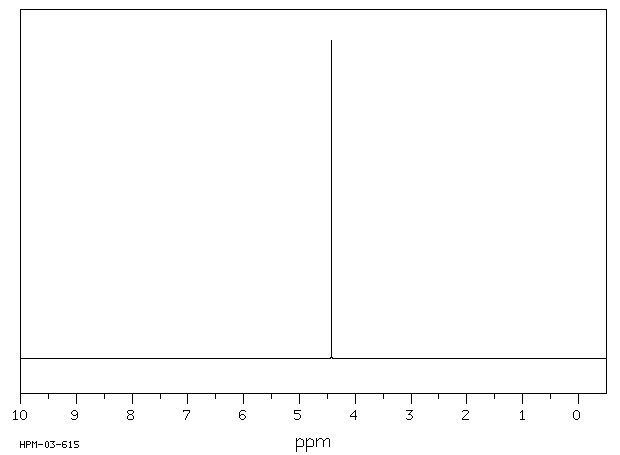N,N-二硅烷基-硅烷胺 | 13862-16-3
分子结构分类
中文名称
N,N-二硅烷基-硅烷胺
中文别名
——
英文名称
trisilylamine
英文别名
——
CAS
13862-16-3
化学式
H9NSi3
mdl
——
分子量
107.335
InChiKey
VOSJXMPCFODQAR-UHFFFAOYSA-N
BEILSTEIN
——
EINECS
——
-
物化性质
-
计算性质
-
ADMET
-
安全信息
-
SDS
-
制备方法与用途
-
上下游信息
-
文献信息
-
表征谱图
-
同类化合物
-
相关功能分类
-
相关结构分类
物化性质
-
熔点:-106°C
-
沸点:52°C
-
密度:0.79g/cm3 at 20℃
-
闪点:-48°C (-54°F)
计算性质
-
辛醇/水分配系数(LogP):-3.87
-
重原子数:4
-
可旋转键数:0
-
环数:0.0
-
sp3杂化的碳原子比例:0.0
-
拓扑面积:3.2
-
氢给体数:0
-
氢受体数:1
SDS
反应信息
-
作为反应物:描述:参考文献:名称:Stock, A.; Somieski, K., Chemische Berichte, 1921, vol. 54, p. 740 - 758摘要:DOI:
-
作为产物:描述:参考文献:名称:Apparatus and method for the production of trisilyamine摘要:描述了一种在管式层流、塞流反应器中以高收率制备硅氨的过程,特别是三硅氨(TSA),从氨气和单卤代硅烷气体中。该装置可以是一个管式流动反应器,包括反应器的第一部分定义气体进入区,第二部分定义反应区和第三部分定义分离区,反应区提供反应物接触区域。三硅氨可以在分离区中在冷凝器收集容器中回收。公开号:US08669387B2
文献信息
-
Apparatus and method for the condensed phase production of trisilylamine申请人:L'Air Liquide Société Anonyme pour l'Etude et L'Exploitation des Procédés Georges Claude公开号:US09446958B2公开(公告)日:2016-09-20The present invention is directed to a condensed phase batch process for synthesis of trisilylamine (TSA). An improved synthesis process that incorporates a solvent to help promote a condensed-phase reaction between ammonia gas (or liquid) and liquified monochlorosilane (MCS) in good yields is described. This process facilitates the removal of the byproduct waste with little to no reactor down time, substantial reduction of down-stream solids contamination and high-purity product from first-pass distillation.
-
Silyl and germyl complexes of platinum and palladium. Part 4. Reactions between four-co-ordinated halogenohydridobis(triethylphosphine)platinum(II) complexes and silyl-amines or -phosphines作者:E. A. V. Ebsworth、Joyce M. Edward、David W. H. RankinDOI:10.1039/dt9760001673日期:——Reactions between NH(SiH3)2 and trans-[PtH(I)(PEt3)2] give trans-[PtI(PEt3)2(H2SiNHSiH3)] and trans-[PtI(PEt3)2(SiH2)}2NH]; with N(SiH3)3, only trans-[PtI(PEt3)2H2SiN(SiH3)2}] is formed, probably for steric reasons. With PH2(SiH3) or PH(SiH3)2, PH3 and trans-[PtI(PEt3)2(SiH3)] are produced; P(SiH3)3 reacts with a four-fold excess of trans-[PtH(I)(PEt3)2] to give PH3 and trans-[PtI(PEt3)2(SiH3)],NH(SiH 3)2和反式-[PTH(I)(PEt 3)2 ]之间的反应得到反式-[PTI(PEt 3)2(H 2 SiNHSiH 3)]和反式-[PTI(PEt 3)2(SiH 2)} 2 NH];对于N(SiH 3)3,仅出于反位原因,仅形成反式-[PTI(PEt 3)2 H 2 SiN(SiH 3)2 }]。有PH 2生成(SiH 3)或PH(SiH 3)2,PH 3和反式-[PTI(PEt 3)2(SiH 3)];P(SiH 3)3与过量四倍的反式-[PTH(I)(PEt 3)2 ]反应生成PH 3和反式-[PTI(PEt 3)2(SiH 3)],但反应比率为1:1至2:1(膦:PT),产物为反式-[PTI(PEt 3)2 H 2SiP的硅烷(SiH 3)2 }]和反式- [PTI(PET 3)2(的SiH 2 } 2 PSiH 3 ]此系列的唯一甲硅烷基化合物,得到具有可识别的种类。反式-
-
Reactions of silanes and germanes with iridium complexes. Part 3. Reactions of some silyl derivatives of O, S, Se, N, and P with trans-carbonyliodobis(triethylphosphine)iridium(I)作者:E. A. V. Ebsworth、Hugh M. Ferrier、Thomas E. FraserDOI:10.1039/dt9810000836日期:——The title complex, trans-[Ir(CO)l(PEt3)2], (1), reacts with Y(SiH3)2(Y = O, S, or Se) in benzene to give [Ir(CO)Hl(PEt3)2(SiH2YSiH3)] or [Ir(CO)Hl(PEt3)2(SiH2)}2Y], although when Y = O the formation of the former species is difficult to detect. Reaction between (1) and P(SiH3)3 leads to the formation of [Ir(CO)Hl(PEt3)2SiH2P(SiH3)2}], [Ir(CO)Hl(PEt3)2(SiH2)}2PSiH3], or [Ir(CO)Hl(PEt3)2(SiH2)}3P]标题化合物反式-[[Ir(CO)1(PEt 3)2 ],与苯中的Y(SiH 3)2(Y = O,S或Se)反应,得到[Ir(CO) Hl(PEt 3)2(SiH 2 YSiH 3)]或[Ir(CO)Hl(PEt 3)2(SiH 2)} 2 Y],尽管当Y = O时,很难检测到前一种物质的形成。(1)与P(SiH 3)3之间的反应导致[Ir(CO)Hl(PEt 3)2 SiH 2 P(SiH 3)2}],[Ir(CO)Hl(PEt 3)2(SiH 2)} 2 PSiH 3 ]或[Ir(CO)Hl(PEt 3)2(SiH 2)} 3 P],具体取决于所取反应物的比例。(1)与N(SiH 3)3之间的反应给出[Ir(CO)Hl(PEt 3)2 SiH 2 N(SiH 3)2 }]和[Ir(CO)Hl(PEt 3)2(SiH 2 }} 2 NSiH 3],但未检测到三(铱二甲硅烷基胺)。通过1
-
Gmelin Handbuch der Anorganischen Chemie, Gmelin Handbook: B: B-Verb.4, 4.4.1, page 110 - 117作者:DOI:——日期:——
-
Gmelin Handbuch der Anorganischen Chemie, Gmelin Handbook: B: B-Verb.4, 4.4.2.3.3, page 126 - 130作者:DOI:——日期:——
表征谱图
-
氢谱1HNMR
-
质谱MS
-
碳谱13CNMR
-
红外IR
-
拉曼Raman
-
峰位数据
-
峰位匹配
-
表征信息







